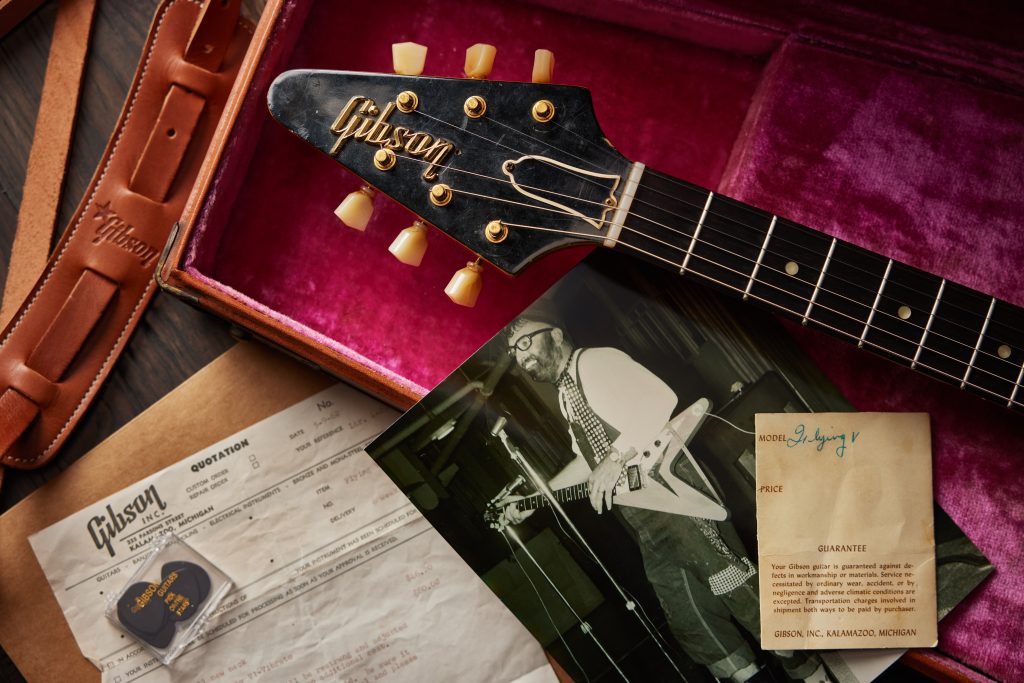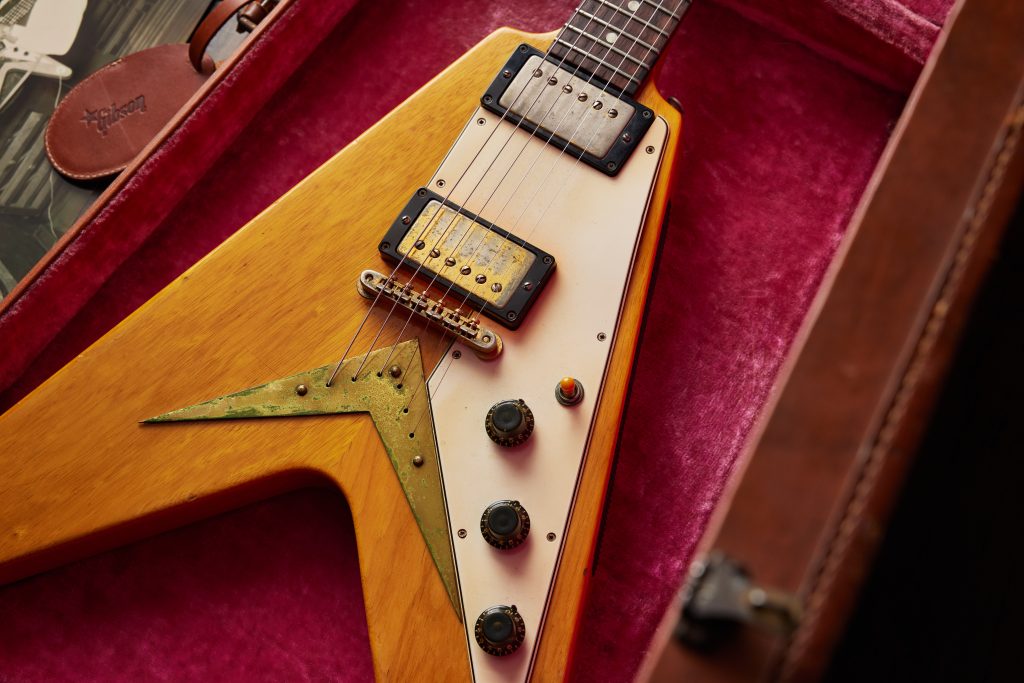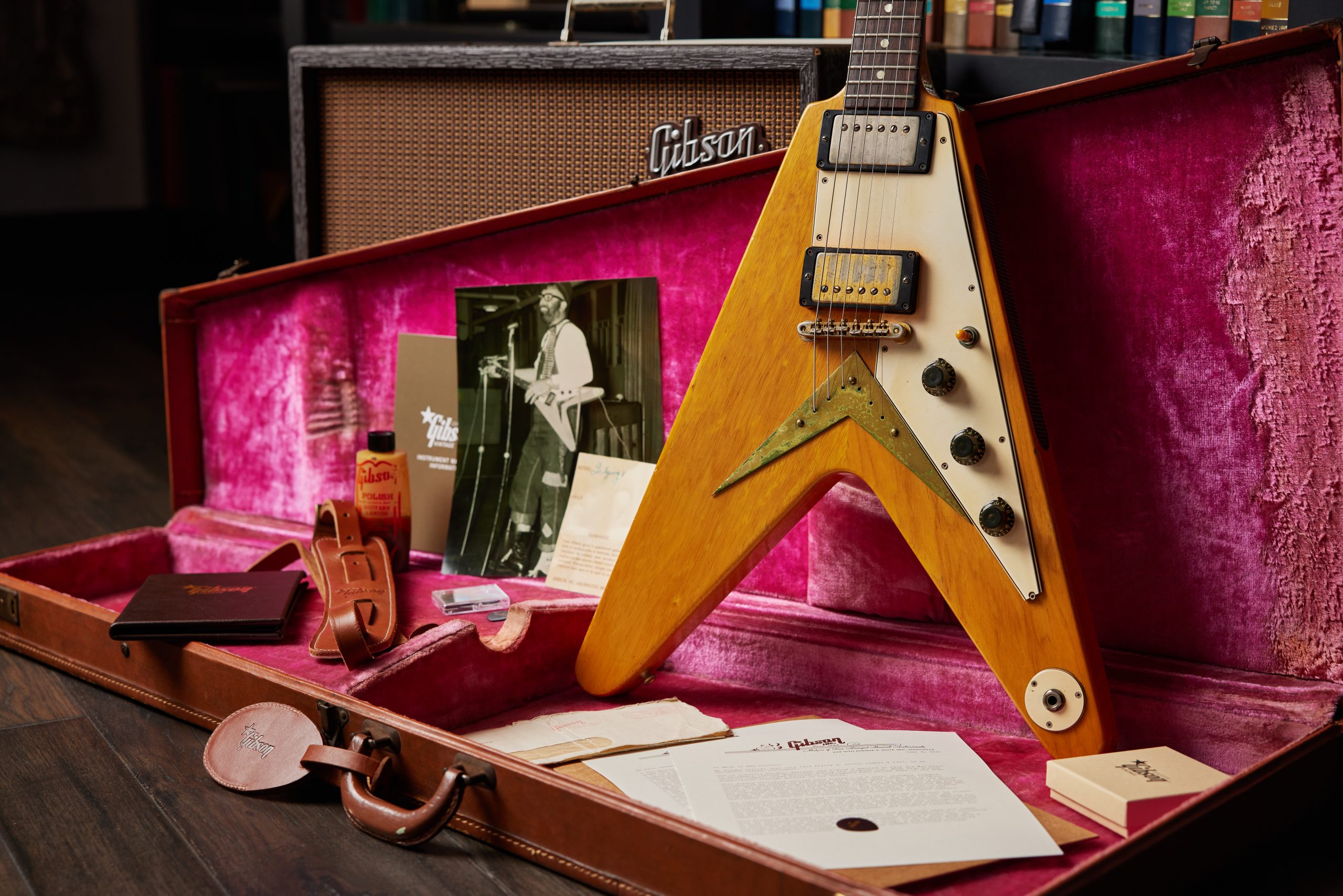Since 2023, Gibson Certified Vintage has provided vintage guitar buyers with an unmatched level of assurance. Its latest drop contains one of the most sought-after vintage instruments of them all…
There aren’t too many guitars that set the pulses of vintage guitar collectors racing like an original Gibson from the late 1950s. And even though the program has already procured and sold 1959 and 1960 Bursts, the latest Gibson Certified Vintage drop contains an even rarer (and even more valuable) vintage Gibson in the unmistakable shape of a stellar 1959 Flying V™.
One of only 17 that were manufactured during the second year of the model’s existence, this ’59 Flying V comes with extensive provenance, cool case candy, and a couple of interesting quirks. Oh, and following a close encounter with the guitar at Garage Fest, we can confirm that it is as light and resonant as you’d expect and sounds absolutely phenomenal. It’s a real heartbreaker. Here, we catch up with Certified Vintage Manager and vintage guitar aficionado Mitch Conrad to get the full story and find out what’s next for the groundbreaking Gibson Certified Vintage program.
Due to the sheer scarcity and value of original Korina guitars, opportunities to buy them don’t come knocking on the door every day. How did you track this one down?
“Last year, one of our team members received an email from the family of the original owner. It was like, ‘We’ve got this, we’ve looked into it a little bit, but we would like some more info.’ Mark Agnesi went up to Ohio, heard the stories from the family, and was able to purchase the guitar and bring it back. The original owner was a man named Howard Swink; he bought the guitar new in Hawaii. It’s a little bit strange in that he played it left-handed—the photo that we have shows the guitar with the badge on the headstock flipped 180 degrees.
“The strangest feature on the guitar is that the strap button is on the treble side—which makes sense for a left-handed Flying V—but it has only ever been on that side, it was never moved. So there’s this mystery of whether it was ordered from Gibson and whether they had a V that was unfinished that was already routed, and whether they couldn’t do a full leftie but could at least locate the strap button in the right place. So it’s uncertain, but very interesting, and nonetheless has all the necessary hallmarks alongside the provenance to be sure it’s what it ought to be.”

Image: In addition to a photograph of the guitar’s original owner in full “Hill Willy” stage attire, the 1959 Flying V comes with case candy such as the original guarantee card and a quotation letter from Gibson for modification work that was never carried out
Once he had the guitar, what do we know about what Howard did with it, and what other provenance does it have?
“Howard played in the band Curt’s Country Cousins under the stage name ‘Hill Willy.’ He had a sort of hillbilly clown shtick. We have a photo of him playing with the band, which is great. He played the guitar, and it was not abused by any means, but it was definitely played. It’s unclear how long he stayed in Hawaii, but he was back in Maryland in 1962, when we got this return letter from Gibson. Howard had reached out to Gibson about having a Bigsby® and a left-handed neck added to the guitar, which is a confusing request. He didn’t move forward with it, but it’s absolutely fascinating to have this repair estimate letter from Gibson. It’s a document format that I’ve never seen before in any Gibson memorabilia, and it’s this added piece of provenance that says ‘Flying V’ on it. You couldn’t ask for something more official than to have a document from Gibson from 1962, referencing this guitar as a Flying V.”
When he was asking for a left-handed neck, do you think he was asking to have the nut flipped?
“It appears that the nut was never flipped; he just strung it the other way around and made do. Potentially, he hadn’t flipped the badge yet and wanted that done too. It’s unclear what he was going for, but he played the thing heavily. There’s no significant wear on the guitar itself—it’s just like a well-loved but appropriately clean guitar—but the frets were worn down to almost nothing. The bridge pickup had been flipped 180 degrees, and it had been like that for some time, based on the photo that we have. The bridge had flattened out quite a bit as well.
“When we took the guitar to Glaser Instruments in Nashville for them to breathe new life into it, we had it refretted with ’59-spec frets. Luckily, Glaser was able to bend the bridge back into shape so we were able to keep the original bridge on the guitar. The tuner buttons had crumbled, as we would expect to see on guitars from that era, so new buttons were put on the original tuners, along with a new nylon nut. The guitar came back from Glazer as this really great playing instrument. The nut is a righty because the assumption is that the new owner is more likely than not to be right-handed. We didn’t feel that we were being disingenuous to the guitar’s history. If it had truly been a factory lefty, it would have been much more appropriate to be brought back as a lefty.”

Image: It’s hard to imagine a cooler vintage guitar package than this
What about the electronics?
“The final piece of the puzzle was a little bit of work on the neck pickup by Jared Brandon, the Gibson Pickup Shop Manager, who has spent more time with Patent Applied For pickups than most people I know. He was able to do an incredible job, rewinding the slug coil of the neck pickup. That was all that needed to be done. And it was an incredibly noninvasive surgery for what that job is. He was able to pull the cover and remove just the slug coil, not touching the leads to the potentiometer, and really doing the minimal amount of unsoldering. He was able to rewind that coil back to an appropriate spec, reinstall it, and keep the guitar in beautiful shape. And it sounds amazing.
“The sentiment really is that, when these guitars come back to us, the work being done is as close as possible to the work that would have been done in the vintage era, with full integrity and respect for what the instrument is. It’s done in a way that is as minimally invasive as possible and retains all of the historic persona and value, while keeping the guitar alive. It really is a restoration. Now you end up with a guitar that does what it was supposed to do when it left the factory, and it feels and sounds great.”

Image: Gibson pickup guru Jared Brandon restored the guitar’s original Patent Applied For neck pickup
How do you feel about this guitar in the context of the wider Gibson Certified Vintage program?
“This is the first 1959 Flying V to be certified with the program, so it’s an exciting thing from that standpoint, but it’s also exciting from the overall standpoint of what we can provide in the industry. The opportunity that we have is to provide peace of mind and clarity in the vintage guitar world, which can be a murky place. This is a situation where we’re able to provide an opportunity for someone to purchase one of the rarest and most collectable instruments—one of 17 made in 1959—with complete confidence that it is exactly what we’re saying it is. We have photographic documentation, we have the story that goes with it, we have additional provenance, and the familiarity with these instruments to be able to speak to them and say, ‘This has all the appropriate hallmarks of a Korina Flying V.’
“This also gives people a chance to be close to something, see something, and be inspired by something that most people won’t get the opportunity to see. Maybe there’s an eight-year-old kid who walks through the Gibson Garage and sees this Flying V behind the glass case, and their eyes just light up. Maybe that kid goes home with an Epiphone Flying V. That might be the person in 40 years who has worked hard, made great money, and now they are the preservationist with the opportunity to buy this guitar and be its next custodian. We’re just part of its story. One of the responsibilities of the Certified Vintage program is to be responsible custodians and extend the lifespan of these instruments for generations of future owners.”

Image: Although the guitar’s hardware has the patina of age and much of the gold is worn away, it’s in remarkable condition overall for an instrument from the late 1950s that was clearly much loved and well played.
An original 1959 Flying V is clearly an extremely rare guitar. Other original Korina instruments aside, are there any other unicorns you are chasing for the program?
“The world of custom colors for Gibson is always a fun, shallow pool. Pre-60s, and even early 60s, finding custom-color pieces and true one-off items that were ordered or employee-made guitars from that timeline… all these things that came out of Kalamazoo that absolutely have Gibson written all over them, but we just don’t have a reference point for. Those things are always a treat. There’s also some hopeful storytelling; what ledgers could we recover, or uncover, or find on a shelf somewhere? What prototypes of other futuristic 50s models, for which it’s unclear if they were made or not, could be found and recovered? Things that I suppose help to fill gaps in the story.
“There are chunks of our history that just have not been accounted for in ways that tell the full story. We want to keep pulling more of that back so that we can pull that together. There are so many employee instruments out there that are a color they should not be, or a model that didn’t quite exist, or that have a pickup or parts configuration that’s not in the catalog. We don’t want to be a museum of oddities when it comes to guitars, but finding those pieces can help fill out the story.”
Do you foresee Gibson Certified Vintage collaborations with artists happening in the future?
“I would absolutely love to, especially as we think, too, about the potential for expanding internationally. I would love to be able to work with artists who have already built up beautiful collections of instruments and are ready to let a few things go, and be able to have those collaborative releases through Certified Vintage. I think that would be a really, really great opportunity. And I think there’s an opportunity for collaborative storytelling, even within the company. There may be a day where we find an exceptional instrument that’s got the perfect characteristics—a killer Goldtop that has just this incredible wear pattern, for example—and we may we want to make a Gibson Custom version of it. Or maybe it’s something that gets added to the Made to Measure menu.
“I think there’s space for Gibson Certified Vintage to be something that, as a company, allows us to learn more about ourselves and our history, implementing the information we learn from these guitars in the pursuit of even greater historical accuracy and expanding that to Gibson USA and Epiphone. But then also being able to push that out further into working with artists collaboratively, and giving these guitars back out into the world to be played and enjoyed forever.”
Visit Gibson Certified Vintage to learn more, and follow the program on Instagram to see more guitars and exclusive behind-the-scenes content from Mitch’s guitar safaris.

